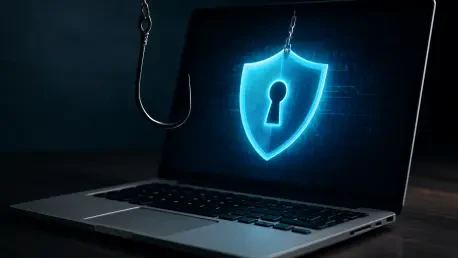In a world where a single text message can drain bank accounts, the rise of sophisticated cyber scams has become a chilling reality that threatens millions of unsuspecting individuals. Picture receiving an urgent SMS about a stuck package or an unpaid toll, only to click a link that steals personal data. This is the deceptive power of the Lighthouse phishing scam, a global operation that has ensnared over one million victims across 120 countries. With credit card details of up to 115 million Americans potentially compromised, the stakes are staggering. How is a tech giant like Google stepping into the ring to combat this digital deception? This exploration uncovers the strategies, challenges, and human impact of a battle against an elusive enemy.
Unmasking a Digital Deception: Why Lighthouse Matters
The Lighthouse phishing scam operates as a sinister phishing-as-a-service model, enabling cybercriminals to distribute malicious messages at an unprecedented scale. Disguised as legitimate alerts from trusted entities, these SMS traps lure users into revealing sensitive information like email credentials and banking details. What makes this operation particularly alarming is its audacity in exploiting everyday trust, turning routine notifications into weapons of fraud. The sheer reach of this scam, affecting countless individuals worldwide, has placed it squarely on the radar of major tech players.
Google’s attention to this threat stems from the direct misuse of its branding in the scam’s tactics. Cybercriminals have crafted 107 fake website templates mimicking the company’s sign-in pages, deceiving users into handing over personal data. This blatant exploitation of a familiar name underscores the broader danger of brand impersonation in cybercrime. As a result, the fight against Lighthouse is not just about protecting users but also about safeguarding corporate identity from malicious distortion.
The urgency to address this issue is amplified by the scam’s evolution into a highly organized network, believed to be orchestrated by individuals based in China. This global dimension complicates efforts to dismantle the operation, as it spans jurisdictions and exploits technological vulnerabilities. Understanding the depth of this deception is crucial to grasping why a coordinated response from industry leaders has become non-negotiable.
The Scale of Smishing: A Growing Cyber Epidemic
Phishing attacks have morphed from dubious emails into sophisticated SMS-based schemes, commonly known as smishing, with a reported five-fold increase in incidents since just a few years ago. This alarming trend reflects how cybercriminals adapt to user behavior, capitalizing on the immediacy and trust associated with text messages. Lighthouse stands as a prime example, with its potential to compromise millions of credit cards in the US alone, painting a grim picture of financial insecurity for countless households.
The real-world impact of these scams is devastating, as victims often face not only monetary loss but also the daunting task of reclaiming their digital identities. Beyond individual harm, the misuse of recognizable branding in fake messages erodes public confidence in legitimate communications. When a text mimicking a well-known company leads to fraud, the ripple effect damages trust in digital interactions as a whole, posing a societal challenge.
This epidemic’s growth signals a shift in cybercrime toward more personal and direct methods of attack. With smishing becoming a preferred tool for scammers, the accessibility of mobile devices turns every user into a potential target. The numbers speak volumes, highlighting an urgent need for robust defenses against a threat that exploits the very technology meant to connect people.
Google’s Multi-Pronged Counterattack Against Lighthouse
Google has launched a comprehensive strategy to tackle the Lighthouse operation, focusing on legal, legislative, and technological fronts. On the legal side, a lawsuit targets 25 unnamed individuals, likely based in China, under significant US laws such as the Racketeer Influenced and Corrupt Organizations Act and the Computer Fraud and Abuse Act. The goal is to dismantle the scam’s infrastructure through restraining orders and damages, while also pushing web hosts to block associated domains and IP addresses.
Legislatively, the company backs bipartisan efforts in the US, supporting bills like the Guarding Unprotected Aging Retirees from Deception (GUARD) Act and the Scam Compound Accountability and Mobilization (SCAM) Act. These proposed laws aim to establish task forces and funding to investigate and curb cyber scams, reflecting a shared recognition of the need for government involvement. Such advocacy underscores a commitment to shaping policies that address the systemic roots of digital fraud.
Technologically, advanced AI-driven tools are being deployed to detect and flag phishing attempts before they reach users. These innovations aim to stay ahead of evolving scam tactics by identifying suspicious patterns in real time. Together, these three pillars form a robust defense mechanism, illustrating a determination to disrupt global scam networks through a blend of enforcement, policy, and cutting-edge solutions.
Voices from the Field: Expert Insights and Sobering Realities
Despite Google’s aggressive stance, skepticism persists about the long-term efficacy of these efforts. Carl Wearn, head of threat intelligence at Mimecast, compares the battle to a game of whack-a-mole, suggesting that while one operation like Lighthouse may be disrupted, others inevitably emerge with new strategies. His perspective highlights the adaptive resilience of cybercriminals, who quickly pivot to alternative methods to exploit vulnerabilities.
The human element at the core of these scams adds another layer of complexity. Scammers prey on inherent trust in familiar platforms like SMS, manipulating emotions with urgent or alarming messages. With millions of victims already affected, the scale of loss—both financial and emotional—serves as a stark reminder of the personal toll behind the statistics. This reality fuels the debate over whether technological and legal measures alone can outpace such deeply rooted tactics.
Wearn’s insights also point to the challenge of jurisdictional barriers in tackling a globally dispersed threat. As phishing operations span borders, coordinated international responses become essential yet difficult to achieve. This sobering view tempers optimism, raising critical questions about the sustainability of current strategies in a landscape where scammers continuously innovate.
Arming Users: Practical Steps to Dodge Phishing Traps
While corporate efforts are vital, individual vigilance remains a key defense against smishing scams like Lighthouse. Users can start by scrutinizing SMS messages for red flags, such as urgent demands for action or links that seem out of place, even if they appear to come from trusted brands. Taking a moment to verify the sender through official channels before responding can prevent falling into a trap.
Adopting simple habits also bolsters personal security. Avoid clicking on unsolicited links, and instead navigate directly to a company’s official website or app to address any concerns. Google offers tools within its ecosystem to flag potential threats, and enabling these features can provide an additional layer of protection. Awareness of these resources empowers users to act as their own first line of defense.
Education plays a pivotal role in this ongoing fight. Staying informed about common scam tactics and sharing knowledge with others, especially vulnerable groups, can reduce the success rate of phishing attempts. By combining personal caution with available technology, individuals contribute significantly to weakening the impact of operations that thrive on uninformed targets.
Final Reflections
Looking back, the fight against the Lighthouse phishing scam revealed the staggering reach of digital deception, with millions of lives disrupted by a single malicious text. Google’s multifaceted approach—spanning lawsuits, legislative support, and AI innovations—marked a bold stand against an ever-evolving threat. Yet, the persistent adaptability of cybercriminals, as noted by experts, underscored that no single solution could fully eradicate the problem.
Moving forward, a collaborative path emerged as the most viable option. Strengthening international cooperation to address jurisdictional challenges became a priority, alongside continued advancements in detection technologies. Empowering users through education also stood out as a critical step, ensuring that awareness kept pace with scam sophistication.
The journey ahead demanded sustained effort from all stakeholders—tech giants, policymakers, and individuals alike. By fostering a culture of vigilance and supporting systemic reforms, society could build stronger defenses against future cyber threats. This collective resolve offered hope, turning a daunting challenge into an opportunity for lasting change.









